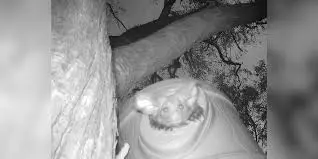She’s even cuter in color 😍
In June 2024, a team of animal scientists placed 12 custom habitat boxes equipped with solar-powered cameras throughout Dingo Mountain in New South Wales, Australia. Their hope? To catch a glimpse of a rare and elusive creature making itself at home.
Months later, their patience was rewarded. As researchers reviewed the footage, one clip stopped them in their tracks — an adorable, fuzzy face peeked out from one of the boxes. The team was overjoyed.
The visitor was a greater glider, a nocturnal marsupial known for its oversized ears, plush fur, and long, bushy tail. As its name suggests, the greater glider doesn’t just climb — it soars. With a membrane stretching from wrist to ankle, it glides effortlessly between treetops under the cover of night.
But sightings like this have become increasingly rare. In the last 20 years, greater glider populations have plummeted by 80%, according to the Australian Conservation Foundation. The culprits: climate change, deforestation, and devastating bushfires. As tree hollows — their natural homes — vanish, so too do the gliders.
The loss is deeply felt beyond the species itself. As WWF Australia explains, greater gliders are “indicators of forest health,” often found only in tall, thriving forests. Their presence tells scientists a forest is doing well. Their absence, however, rings alarm bells.
This sighting is part of the Bunyas to Border (B2B) Koala Climate Corridors project, which aims to restore critical habitats and climate-resilient wildlife corridors for threatened species like the greater glider and koala. Installing habitat boxes was one creative solution — and seeing one used confirmed their efforts were making a difference.
“It’s always wonderful to see our nest boxes being used by the target species — and extra special when it’s a threatened species such as the greater glider,” said Mick Callan, B2B’s director of habitat innovation and management, in a statement to The Great Eastern Ranges.
Buoyed by the success, the team now hopes to expand the project, seeking funding to install even more habitat boxes throughout the region. Each one could be a new home — and a new chance — for the greater glider.
With luck and continued conservation, perhaps one day spotting a greater glider in the wild won’t be a rare event — but a familiar and welcome sight beneath the moonlit canopy.
